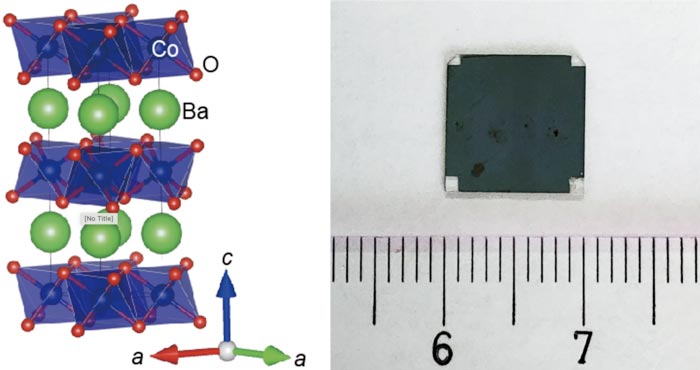Efficient, stable, and eco-friendly thermoelectric material discovered

The crystal structure of the barium cobalt oxide film (left; Xi Zhang, Yuqiao Zhang, et al. ACS Applied Materials & Interfaces. July 12, 2022), and the metal oxide film itself (right; Photo: Hiromichi Ohta).
Credit: Xi Zhang, Yuqiao Zhang, et al. ACS Applied Materials & Interfaces. July 12, 2022; Hiromichi Ohta
Waste heat is a very promising source of energy conservation and reuse, by means of converting this heat into electricity—a process called thermoelectric conversion. Commercially available thermoelectric conversion devices are synthesized using rare metals. While these are quite efficient, they are expensive and, in the majority of cases, utilize toxic materials. Both these factors have led to these converters being of limited use. One of the alternatives are oxide-based thermoelectric materials, but the primary drawback these suffer from is a lack of evidence of their stability at high temperatures.
A team led by Professor Hiromichi Ohta at the Research Institute for Electronic Science at Hokkaido University has synthesised a barium cobalt oxide thermoelectric converter that is reproducibly stable and efficient at temperatures as high as 600°C. Their findings were published in the journal ACS Applied Materials & Interfaces.
Thermoelectric conversion is driven by the Seebeck effect: when there is a temperature difference across a conducting material, an electric current is generated. However, efficiency of thermoelectric conversion is dependent on a figure called the thermoelectric figure of merit ZT. Historically, oxide-based converters had a low ZT, but recent research has revealed many candidates that have high ZT, but their stability at high temperatures was not well documented.
Hiromichi Ohta’s group has been working on layered cobalt oxide films for over two decades. In this study, the team sought to examine the thermal and chemical stability of these films, as well as measure their ZT values, at high temperatures. They tested cobalt oxide films layered with sodium, calcium, strontium or barium, analysing their structure, resistivity, and thermal conductivity.
They found that, of the four variants, the barium cobalt oxide layered film retained its stability in terms of structural integrity and electrical resistivity at temperatures as high as 600°C. In comparison, the sodium- and calcium cobalt oxide films were only stable until 350°C, and the strontium cobalt oxide film was stable up to 450°C. The ZT of the barium cobalt oxide film increased with the temperature, reaching ~0.55 at 600°C, comparable to some commercially available thermoelectric converters.
“Our study has shown that barium cobalt oxide films would be excellent candidates for high-temperature thermoelectric conversion devices,” said Hiromichi Ohta. “ In addition, they are environment friendly, giving potential for wide deployment.”
Journal: ACS Applied Materials & Interfaces
DOI: 10.1021/acsami.2c08555
Method of Research: Experimental study
Subject of Research: Not applicable
Article Title: Ba1/3CoO2: A thermoelectric oxide showing a reliable ZT of ~0.55 at 600 °C in air
Article Publication Date: 12-Jul-2022
Media Contact
Sohail Keegan Pinto
Hokkaido University
en-press@general.hokudai.ac.jp
Office: +81-11-706-2186
All latest news from the category: Materials Sciences
Materials management deals with the research, development, manufacturing and processing of raw and industrial materials. Key aspects here are biological and medical issues, which play an increasingly important role in this field.
innovations-report offers in-depth articles related to the development and application of materials and the structure and properties of new materials.
Newest articles

Innovative 3D printed scaffolds offer new hope for bone healing
Researchers at the Institute for Bioengineering of Catalonia have developed novel 3D printed PLA-CaP scaffolds that promote blood vessel formation, ensuring better healing and regeneration of bone tissue. Bone is…

The surprising role of gut infection in Alzheimer’s disease
ASU- and Banner Alzheimer’s Institute-led study implicates link between a common virus and the disease, which travels from the gut to the brain and may be a target for antiviral…

Molecular gardening: New enzymes discovered for protein modification pruning
How deubiquitinases USP53 and USP54 cleave long polyubiquitin chains and how the former is linked to liver disease in children. Deubiquitinases (DUBs) are enzymes used by cells to trim protein…



